growing
PALMS
& CYCADS
outside in the UK
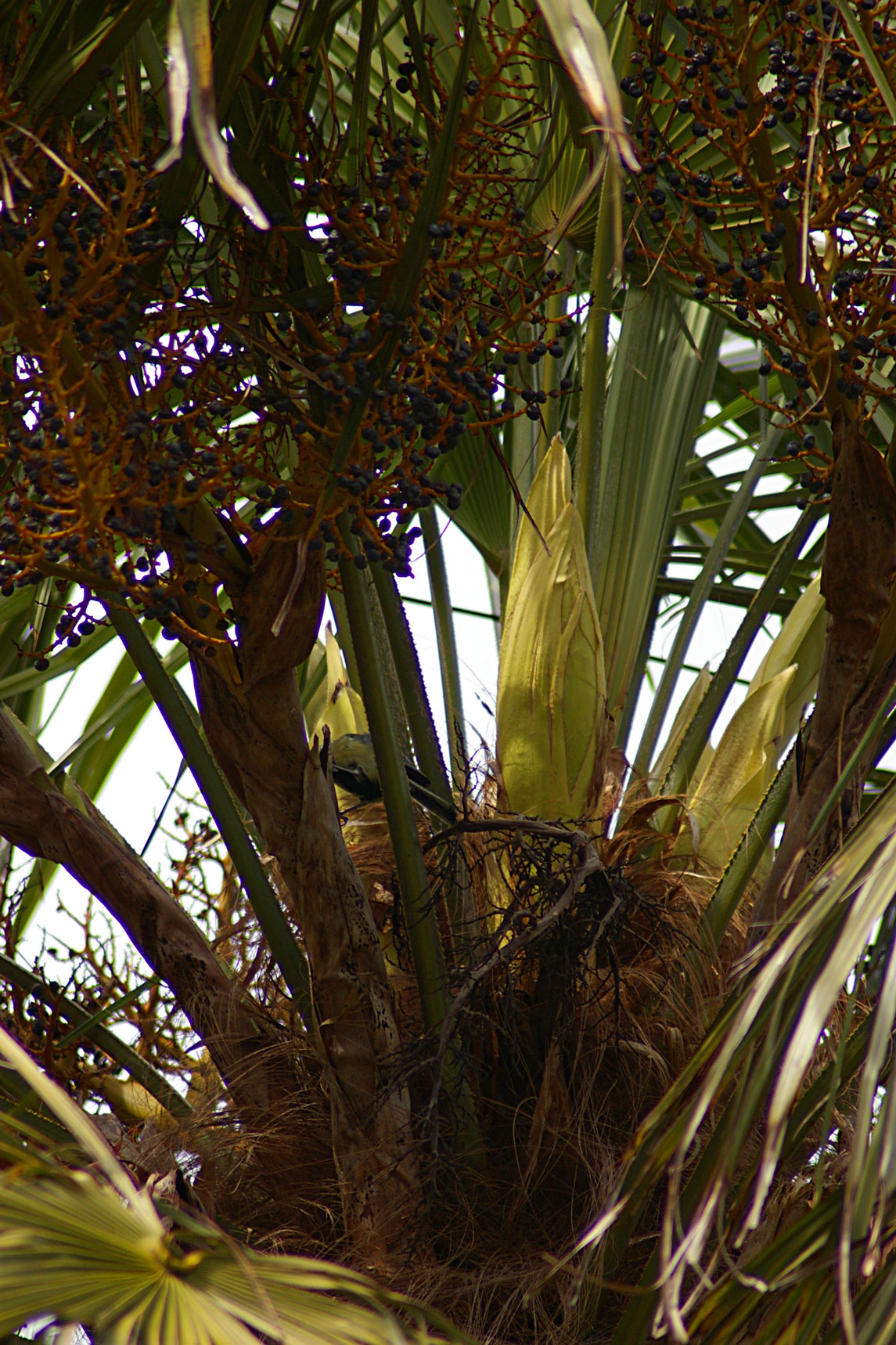 |
Looking
directly into the crown of a Trachycarpus fortunei. Amid
the remains of the previous season's seeds new potent looking flower
buds about to burst. This species seeds itself very rapidly around the garden with the result that it soon becomes a weed. It is therefore wise to dead-head soon after flowering (or grow males only). |
General
Palms are often considered to be the standard bearers of exotic gardening in the U.K.. It is difficult to disagree. Almost all gardeners who wish to create an exotic garden will sooner or later, generally sooner rather than later, incorporate at least one palm into their scheme. This is not without its pitfalls: sound advice on growing palms is not always readily available outside specialist nurseries, often plants inappropriate for our climate are offered for sale, on many occasions plants are mislabeled and sometimes the growing point may be damaged -
The palm section has proved to be the most popular part of this website. This is not surprising since gardeners are beginning to realise that these exotic archetypes are easy to grow (provided that basic conditions are right). Often expensive specimens are bought on impulse. This section is due to be revised and extended in the near future and if you have found the information useful I strongly advise you to return here within a month or two. All comments (by e-mail) are gratefully received and I always try to reply serious correspondence. |
The most important question for gardeners is which of the 1,500 or so species are suitable for growing outside in the U.K.. Let us not be fooled, there are not many. But from thegardener's (as opposed to the specialist collector's) point of view, because palms are so similar in appearance, it can be argued that the assortment is quite adequate. I have experimented with a number of species here in Torquay (admittedly a climatically favoured locality) and have observed many palms growing elsewhere. I find that it is therefore quite feasible to draw up a list of 'possibles' and an obviously shorter list of 'probables and certs' which can be grown in the U.K., especially in the south. There remain a few other species which might fit into either of the lists but I have ignored them because they are either too expensive, too difficult to find or not particularly interesting for the gardener. I have direct personal experience of almost all the palms I list below and also information from my local gardening associates.
| Probables and certs | Zone | Additional possibles | Zone |
Fan
palms: |
|
Fan
palms: |
|
Footnotes |
|||
Palms are trees but they are quite unlike any other tree. Typically, they do not have branching trunks nor do they have any branches at all. They have a crown of large leaves at the top of the trunk which, once fully formed, does not significantly increase in size. This makes their growth pattern and mature appearance reasonably predictable - unlike that of many trees and shrubs. They can therefore be sited with a fair degree of precision and grow to produce expected results.
Palms do not 'self-repair' any damage caused to their trunk; many other woody plants are able to scar over and re-grow sections of damaged or missing bark. Furthermore, the trunk has no secondary growing points which means lopping of its growing point kills the palm (unless, as in some species of clumping palm, a sucker is sent up from the base). Attention must therefore be paid not to damage either the trunk or the growing point.
There is no tap root present on palms and, although their roots branch, they remain the same diameter throughout their length. As a result their roots will not disturb foundations and they can be planted close to mortared structures (as long as there is room for the crown to develop and room for the trunk to grow). However, some palms (Sabal minor and Nannorrhops ritchiana, for example) may produce a trunk below ground.
Many are sensitive to waterlogging - even those which require moist conditions. Waterlogging is especially harmful in winter when wet freezes can occur, and such conditions need to be avoided with all the palms mentioned here (except, perhaps, Sabal minor). The interesting thing is that some palms (Phoenix canariensis and Washingtonia) actively seek out permanent deep groundwater into which they immerse the ends of their roots; higher up they do not like it. My experience with Trachycarpus fortunei is that it will thrive in very damp, even waterlogged, soil when temperatures are above freezing - such is the case at Southern Comfort where I have several plants growing in very damp conditions. Whether freezing contions would damage such plants I do not know.
All palms are invariably slow-growing but some are significantly slower than others. When considering their part in a gardening scheme they must therefore be treated as long-term plants and it may pay to buy and plant out larger rather than smaller specimens unless you are prepared to wait. Another reason for planting out larger specimens is that hardiness increases dramatically with size. For example, small Washingtonia filifera are quickly killed by the slightest frost whereas larger, trunked, examples will take zone 7 in their stride.
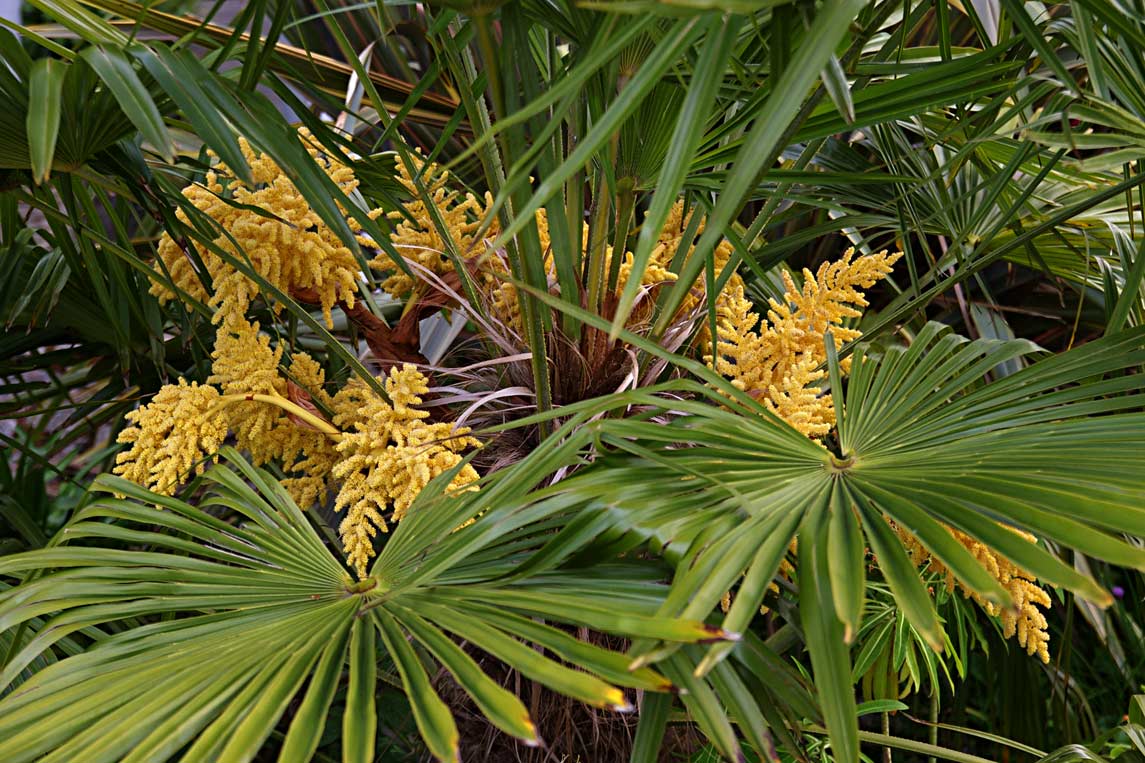 |
| A male Chusan Palm (Trachycarpus fortunei) in full flower during spring (from a distance, male flowers are indistinguishable from female ones). This is one of the hardiest palms available and mature plants are able to overwinter successfully at temperatures down to minus 15°C; importantly, it is fairly fast growing (for a palm) and will grow several leaves in a season. Although other species may take lower winter temperatures they put on far less less growth on account of our cool summers. Trachycarpus fortunei (or its alter ego T. wagrerianus) is 'the' standard palm for the British Isles - it will grow anywhere where trees will grow. |
Prominent Palms in and around Torquay
The Chinese Windmill Palm or Chusan Palm, Trachycarpus fortunei
In the course of exploring Meadfoot Sea Road note can be taken of the very large number of Trachycarpus fortunei growing in gardens mostly on south-facing slope of the valley. In these gardens it self-seeds to the extent of being a weed. Trachycarpus fortunei is a commonly planted palm in Torbay and is present in most of the municipal areas. In such places it is very often found in the company of Cordyline australis, the New Zealand Cabbage Tree, which is often erroneously referred to as a palm. The Trachycarpus planted by the harbourside and along the Sea Front are far from outstanding in their appearance. This may be due to several reasons: closeness to salt spray from the sea, exposure to strong winds or incorrect, maintenance' (mechanical damage, lack of adequate fertilizer etc). However, because some Phoenix canariensis and Chamaerops humilis, also in the same area, do not suffer similarly and look very acceptable, it is likely that exposure to salt spray and strong winds is not to the liking of T. fortunei. Given the choice, I would prefer to position them in a sheltered location and away from salt spray.
Other species of Trachycarpus
There is a slight mystery associated with this item. At the southern end of Oldway Gardens in Paignton the visitor will notice the remnants of an exotic garden complete with grotto. This intriguing little corner does not appear to be particularly well-known to those outside the immediate area. There are a few good sized palms growing in the area which are obviously Trachycarpus. Most of these are undoubtedly Trachycarpus fortunei but a few seem to differ: there are some smooth trunks, some small crowns and some which generate at least some other doubts as to their identity. A Trachycarpus expert is required to come and inspect these palms at first hand.
The Chilean Wine Palm, Jubaea chilensis
Several species of palm can be seen in public places and in private gardens by ordinary road users. The most famous palms are the two Jubaea chilensis in a garden in Hesketh Road in the Meadfoot area of town. More precisely, it is the larger one which is famous. A gate now blocks the grand view from base to crown of this magnificent palm but the missing part can be glimpsed by the edge of the gatepost. Other views can be had walking up to Daddyhole Road on the other side of Meadfoot Sea Road and also from St Mark's Road on the other side of the valley.
The trunk of the larger palm (2012) is approximately 9 metres tall with a diameter of about 1.1 metres. This makes it over 12 meters tall including the upright leaves. This is not a record breaking size but it is still a wonder to behold and unique for the British Isles.
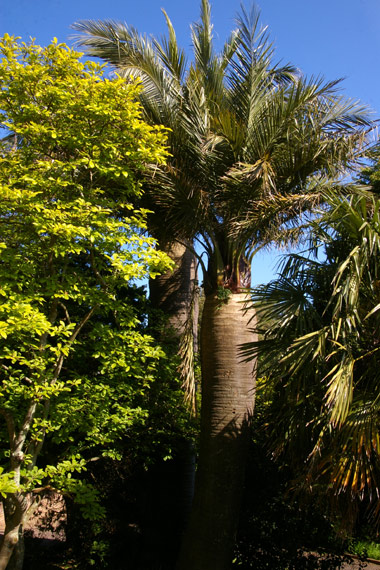 |
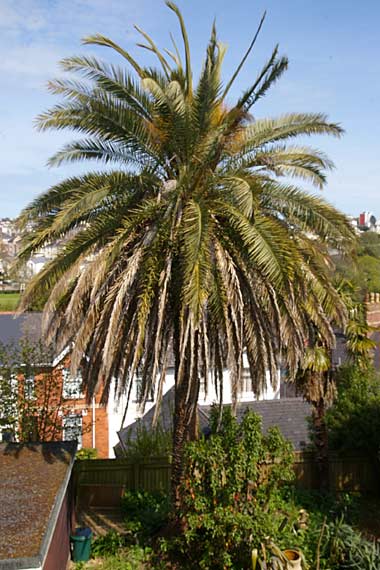 |
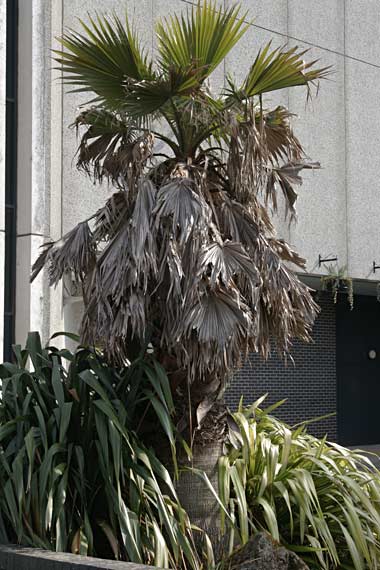 |
| The two most spectacular outside-growing Jubaea chilensis (Chilean Wine Palm) in the U.K.. Originally planted in 1900 as part of a group of three, they are mentioned by W.J. Bean in his classic book Trees and Shrubs Hardy in the British Isles. | The 7½ metre crown of the Phoenix canariensis (Canary Island Date Palm) growing in a private garden in Chelston, Torquay, Devon can be seen from Goshen Road. Its inflorescences are visible above the middle of the crown. | Washingtonia filifera outside the main entrance to the Riviera Centre in Torquay. All the main features of the palm are visible: the soft crown, the 'petticoat', the split bases of the petioles and the heavy base of the trunk. We do not have any of this plant's history. |
The Canary Island Date Palm, Phoenix canariensis
A number Phoenix canariensis have been planted in the Sea Front (between the Princess Theatre and the public conveniences) area by the local authority during recent years. In years to come, unless they are killed during a vicious winter or cut down for reasons of health and safety they will become a prominent and pleasing feature of the town. So far, they have all survived the recent harsh winters without any significant signs of damage. The most prominent one of the group is to be found near the top end of the footbridge serving the confluence of Torbay Road, Belgrave Road and Sheddon Hill Road. There are also many Phoenix canariensis scattered around in private gardens - often unsuitably sited and shortly to outgrow their welcome. As yet they are all still too small to be of special note.
In order, however, to view the best Phoenix canariensis in Torbay we need to travel westwards to Chelston, a pleasantly hilly district of fine Victorian villas now mostly way past their prime. There from Old Mill Road just below the Methodist Church we see the characteristic 7-8 metre crown of the palm as we look downhill towards the east. It is also visible between two houses as we look down from Ashfield Road. Another view, from below, can be had looking north from the bend in Goshen Road. Unfortunately, the 7-8 metre tall trunk of this palm is not visible from the public road.
Although on Tresco in the Scilly Islands there are some large specimens the tallest of which may be 15 metres, this palm may be the tallest one growing on the mainland. I have found no record of anything nearing this height. In this sense it holds the record. However, in terms of sheer size and bulk it is a fairly modest example amongst its kind. Its bare trunk is about 40 cm in diameter and sits on a large matted mound of aerial roots.
The Canary Island Date Palm is respectably hardy (at least down to minus 8°C) so it is surprising that it had not been more widely planted and that there are no similar sized examples of this palm in the South-West. It is likely that a number were planted during the Victorian period and later but over succeeding decades they were gradually whittled down by the colder winters.
Californian Cotton Palm, Washingtonia filifera
Mature and established specimens seem to be fully hardy in the Torbay area. I base this statement on the single plant which has been growing for many years outside the front entrance to the Riviera Centre in Torquay, some 300 metres from the sea. It is growing in the company of Trachycarpus fortunei and if we are not consciously on the lookout for it we will most certainly miss it. I missed it for years and so did my neighbour Steven Tiller who never misses a palm. It is just a few metres tall, with a swollen base to the trunk but it is by no means a prize specimen. But it certainly confirms that Washingtonia filifera is capable of growing in Torquay.
A few years ago the local authority planted a row of trunked Washingtonia filifera further inland in Trematon Avenue, which is about 1000 metres (¾ mile) from the sea. None, as far as I know, survived the recent winters. Either they were still too small or the temperature just that bit lower than at the Riviera Centre or, most probably, a combination of both.
There used to be one decent-sized Washingtonia (probably filifera) growing in the front garden of a run-down hotel in the Babbacombe Road opposite the Palace Hotel. The building was demolished and a block of flats (Anstey Court) built in its place and for a while the palm seemed to have been treated with respect. However, as soon as the flats were given the final polish the Washingtonia suddenly disappeared. It appears that some pansies were tastefully planted in its place.
Mediterranean Fan Palm, Chamaerops humilis
This small palm is not planted in any great quantity in Torquay despite it being easy, as hardy as Phoenix canariensis and always looking good in coastal conditions. A few can be seen in and around the Pavilion, Princess Parade, Abbey Gardens and neighbouring green areas. A specimen by the ornamental pond in Abbey Gardens has now reached an impressive size.
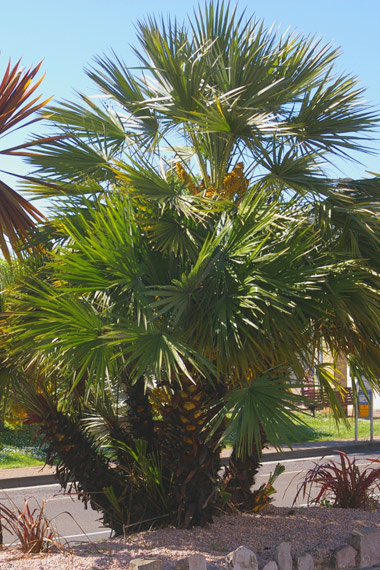 |
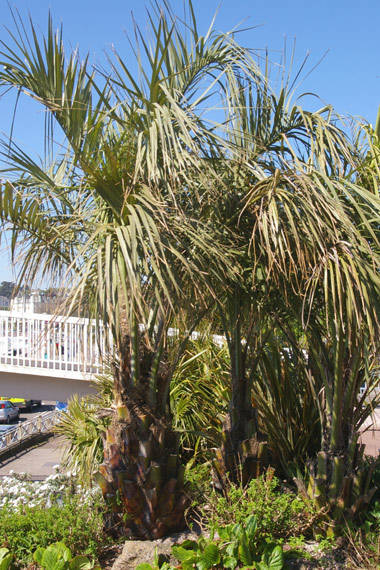 |
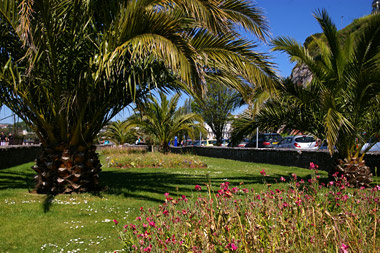 |
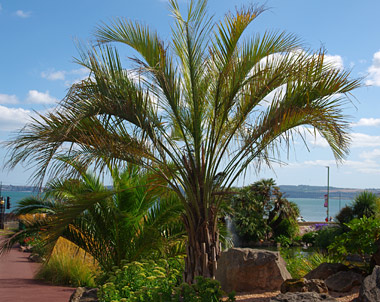 |
||
| A clump of several Chamaerops humilis trunks in the central reservation of Cary Parade, Torquay. Flowers can be seen on some of the plants. This multi-trunked robust species grows well in coastal areas and it is surprising that it is not more widely planted. | A group of three Butia capitata by the sea front in Torquay. Their closeness to each other will ensure the group of a visual disadvantage when they grow to maturity. These do not compete well with the impressive 'Beckenham Butia' (picture taken November 2012) in South London (Bromley Road corner with Oakwood Avenue) which is probably of similar age. | Top: A group of Phoenix canariensis growing along the sea front in Torquay (photo taken in 2006). |
The Jelly Palm, Butia capitata
There are three examples of this silvery-leaved palm growing by the top end of the Sheddon Hill to Torbay Road footbridge. The position is somewhat unfortunate leaving them very exposed to salt spray which they appear not to like, the soil type may also be unsuitable and, worst of all, they are unquestionably too close together. While they have survived the climate here for many years they are suffering as a result of injudicious planting and, when grown and mature, the final visual impact will be way below standard.
A few years ago another example was planted by the harbour on the east side of Cary Parade; it has almost a fully developed crown of leaves but is still trunkless. Although it is hardly a prize specimen I include it here because it is in a very prominent and far more suitable position than the above trio. It also looks very healthy. Let us wish it all the very best and tall may it grow!
Palms for the garden
All the palms in the table above can be used in the garden and all have their merits. However, if I were to select the ones I consider to be 'best', 'easiest', 'most hardy', 'cheapest' I would narrow the already modest list even further. My list thus consists of about eight species of palm and a couple of cycads. The palm collector would almost certainly extend the list and add a few tender species in pots; these would require winter protection.
Professor David A. Francko, writing in Chamaerops (journal of the European Palm Society)* makes some additional suggestions: The Needle Palm (Rhapidophyllum hystrix and the Cabbage Palmetto (Sabal palmetto). I do not have experience of either but they seem promising. At this point it is worth mentioning that the website of the European Palm Society has the full series of the now defunct journal available to read or download. It is a valuable resource for those interested in growing palms in temperate climates.
When buying palms it is probably best to obtain them from a reputable supplier although good specimens of tough plants like Trachycarpus fortunei can be obtained from most garden centres - at least in the southern half of the country. Ensure that the plant has been watered, is not pot-bound and can easily slide out of the pot with the roots holding all the potting medium in place. With the less tough palms like Phoenix it is probably wise to buy in mid to late spring rather than earlier because by then it is clear whether the centrally emerging new leaf (the 'spear') is healthy and has not rotted away at its base during the previous winter. Never buy a plant with a 'dodgy' or missing spear - plants with rotted spears generally do not survive.
Most soils are probably suitable for palms. Two things to avoid are waterlogged soils and thin soils over chalk. Over-use of fertilizers, especially of artificial ones, can be fatal or, at the very least, cause substantial setbacks in growth.
Trachycarpus & Chamaerops
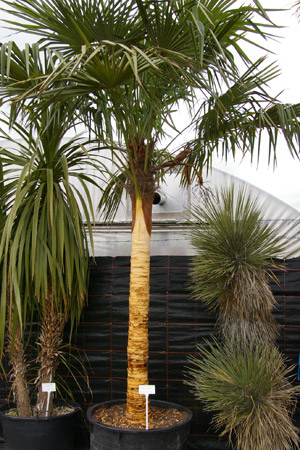 |
| Trachycarpus fortunei with freshly-stripped trunk photographed at Amulree Exotics in Norfolk. The light colour gradually darkens with time. The character of the palm changes significantly once the trunk is stripped. |
My preferred species here would probably be Trachycarpus wagnerianus, Chamaerops humilis and the silver-leaved Chamaerops humilis 'cerifera'. Trachycarpus wagnerianus is more difficult to find than T. fortunei, is slightly slower-growing especially in the early stages, but it is just as hardy but has a far more refined look to it with leaves of a richer dark green. It is also a good deal more robust in strong winds and overall it is an excellent plant. But it is more expensive. When choosing a place for it allow space for an adequate display of its silhouette, give it a good background and company. It will thrive in full sun or in semi-shade provided it has an ordinary garden soil not devoid of nutrients and not waterlogged. Trachycarpus wagnerianus is best bought when it is already showing some trunk - this ensures steady growth from the moment of planting.
Both Trachycarpus and Chamaerops are respectably hardy - Trachycarpus to minus 15°C and Chamaerops a little less so to about minus 10°C. The only two palms (on the above list) hardier than the Trachycarpus are Sabal minor and Rhapidophyllum hystrix but these are more for the specialist: neither generally forms a trunk above ground level, they are both very slow-growing (if you get one leaf a year in this country you are doing well), Sabal minor requires damp soil to do thrive, Rhapidophyllum hystrix requires very high summer temperatures. They are, however, very attractive palms.Some gardeners like to strip the trunks of Trachycarpus fortunei and wagnerianus. There are tips on how to do this on various internet sites. I am not over enthused about this practice and prefer the natural hairy and fibrous look of the palm. One disadvantage of stripping, apart from the hard work itself, is that once started it needs to be continued as the palm grows in order to prevent an incongruous appearance. When the palm eventually grows very tall the mechanics of the procedure can be a problem.
I have a word of warning for those who wish to plant several T. fortunei close together. The palm is a very prolific self-seeder in some localities (it is at Sothern Comfort). If this habit is not held in check problems will arise after a few years as it becomes a rampant weed. Since T. fortunei is dioecious (there are male and female plants) probably the best way around this problem is to plant one sex only - preferably a male. This not always a practical proposition. The second way of dealing with this is to remove the spent female flower stalks soon after flowering so as not to allow any seeds to form. Although with tall trees this requires work from a ladder, often in tricky positions, and is often the sort of job that is put off until too late, it is still easier than what follows. The next stage is to remove all seedlings: those up to two or three seasons old can be easily pulled out by hand. The only daunting matter is that they will be present in their thousands and the job will take many hours. Nevertheless, it will take more even more time when the plants grow larger. Large plants will have to be dug up and this is a job which will sap a gardener's strength and eventually, after a thousand or so, even his will to garden. You have been warned.
Cutting seedlings down to ground level whilst they are smallish will have no effect - new leaves will soon appear from the centre of the stem. Unless, of course, a few drops of systemic herbicide are dropped into the centre of the plant. However, as soon as the palm has a discernable trunk it can be cut down and will then regrow no more. After a few years the trunks will rot away and the area can be re-gardened afresh. I am led to believe that T. wagnerianus is not a rampant self seeder (it does not readily pollinate).
Chamaerops humilis is similar but is a much slower-growing and smaller palm than Trachycarpus and it performs much better in situations of salt winds. While it is generally a clumping palm there are non-clumping clones which are reputedly marginally less hardy. I consider the clumping varieties to be the more attractive although in their early stages they do not look particularly palm-like when the leaves appear to grow haphazardly in all directions. Only when the separate trunks with their crowns of leaves begin to develop does this palm show its true picture-book quality of arching trunks and leaf-crowns at various heights. The variety 'cerifera' from the Atlas Mountains is particularly striking with its silvery blue leaves.
Phoenix, Butia & Jubaea
Both Phoenix canariensis and Jubaea chilensis are monsters eventually growing to over 20 metres in height. A Jubaea may, under optimal conditions, develop a trunk of up to 2 metres in diameter and a crown of up to 7½-8 metres in diameter whilst a Phoenix, with a trunk half the size, can have a crown of up to 12 metres in diameter. Although such sizes are unlikely to be attained in this country these palms need to be sited carefully; it could be argued, however, that because the Jubaea is so slow-growing its siting will only begin to matter to the next or even subsequent generation. Butia capitata and Butia eriospatha are quite similar except that the former has silvery grey leaves and the latter has green ones. They are not as slow-growing as Jubaea but slower than Phoenix canariensis. They are also much smaller. Owen Johnson ("The Plantsman", September 200) mentions that in the U.K. Butia captitata is prone to butt-rot, a fungal disease which attacks after the bases of the trunks have fully developed. B. eriospatha is apparently not attacked by this disease and may therefore prove to be a better bet.
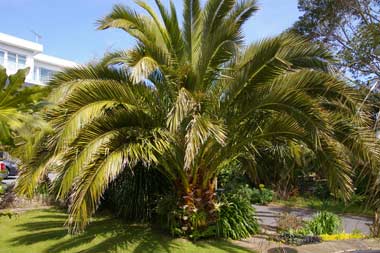 |
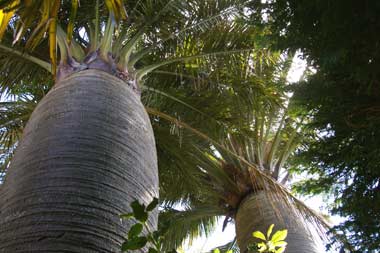 |
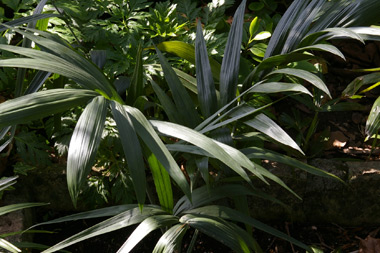 |
| This female Phoenix canariensis at Southern Comfort was planted in the spring of 1998 and has now flowered and fruited for several years. Its total height including leaves is over six metres (photo taken 2012). | A pair of Jubaea chilensis in a neighbouring garden in the Meadfoot Valley. They are now well over 100 years old and this fact is a witness to their hardiness in this part of the country. | Chamaedorea radicalis growing in a damp and shady part of the garden. If you are lucky enough to possess a trunked specimen you will have what is perhaps the only U.K. hardy species of palm to have a crownshaft. |
At Southern Comfort we purchased a Phoenix canariensis in the autumn of 1997 and, after cautiously having overwintered it in its pot, we planted it out during the spring of 1998. With its leaves tied it was about one metre tall, including the pot. Care was taken to site it correctly so as to give it the space it needs and to avoid undue interference by its huge leaves in future years. This decision proved to be sound and the palm began to flower and fruit about seven years later. The fruiting somewhat puzzled me (and still does) because to my knowledge there is no mature male Canary Island Date Palm within the immediate vicinity. However, pollen can be carried for vast distances by the wind and this is certainly what must be occurring. I never got around to trying to germinate any of the seeds. Fifteen years on (2012) it became a spectacular feature in the garden with a crown of leaves some 8 metres in diameter, a 1.1 metre 'trunk' (including leaf bases) which is still swelling and leaves which reach to a height of over 6 metres. The size of the real trunk which is hidden by the leaf bases is, of course, much smaller and difficult to ascertain. Despite the harshness of recent winters we have not observed any damage other than some slight browning of the tips of the older leaves.
The only attention which the tree has received consists of the removal of old leaves as they touch the ground, the removal of spines on the lower leaves and the sprinkling of several ounces of Growmore fertilizer around the base at springtime. This involves very little work with the result that the palm is virtually trouble-free as well as relatively fast-growing.
The slow rate of growth of palms in general should not disguise the fact that much of their potential is reached already when a full crown of leaves is produced - and this is much sooner than typically expected. Indeed, it is arguable that many palms reach the peak of their beauty whilst they are still forming a trunk or soon afterwards. But whatever the merits of this view the slow rate of growth should not discourage anybody from using them in the garden.
Chamaedorea
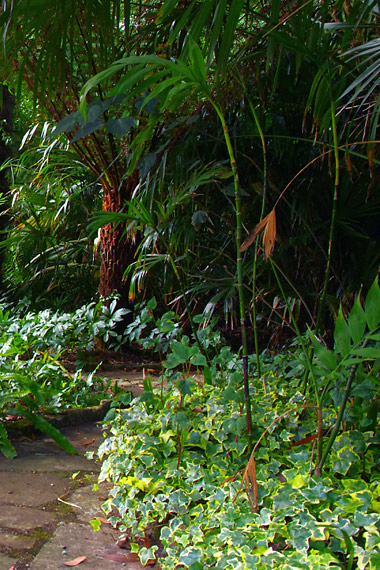 |
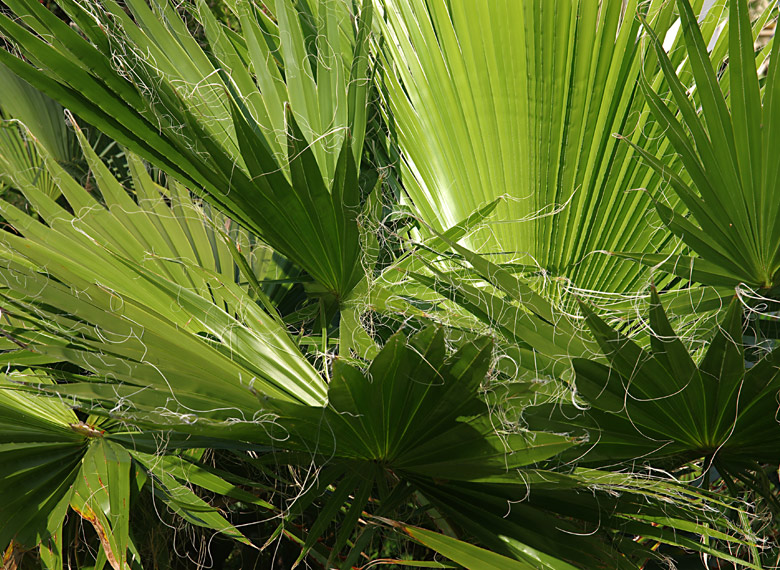 |
| The thin slightly arching trunks of the clumping Chamaedorea microspadix resemble bamboo culms. This palm is often mistaken by the unwary for a bamboo. The trunks reach a height of 3 metres in the wild. | The fresh green foliage of the Washingtonia filifera. Note the characteristic white threads which give it the common name Cotton Palm. Closely related is W. robusta, the Skyduster or Mexican Fan Palm, native to the California area. It is less hardy than W. filifera although a mature specimen would probably take average (or less) South-West winters in its stride. |
This genus of small feather palms contains two dioecious species which currently grow well at Southern Comfort: Chamaedorea radicalis and Chamaedorea microspadix, both from Mexico. Chamaedorea radicalis is a delightful, small, low-growing - almost groundcover - trunkless pinnate palm, although some individuals may form thin trunks of up to four metres. It requires protection from direct sunlight to prevent leaf-burn and to develop the deep green, almost metallic, colour. Each leaf is up to one metre in length thus giving the crown a diameter of up to two metres and the palm is probably best planted in groups. It always manages to look neat and begins to flower and fruit after only a few years. Although rated at climatic zone 9a I have not seen any damage on any of mine over the past few winters. The other species, C. microspadix (the Bamboo Palm - its trunks resemble bamboo culms) is a clumping palm and is somewhat less robust and is probably less garden-worthy but may be slightly hardier.
Chamaedorea radicalis flowers and seeds readily when just just a few years old if both sexes are present. Although I have never identified any natural seedlings I have found most of the seeds to be viable. By gathering them when they turn a bright red colour I have managed to increase my stock of this attractive palm.
Chamaedorea radicalis may not be easy to find but, in my view, it is worth seeking out if exotic-looking ground cover is required in milder localities. Because of its diminutive size and low light requirements, Chamaedorea radicalis can also be grown indoors.
Washingtonia filifera
There are two species of Washingtonia: W. filifera and W. robusta. W. filifera is chunky with a trunk up to a metre or so in diameter, grows up to 20 meteres in height, has characteristic long white thread-like hairs at the tips and sides of the leaves and is the hardier of the two. W. robusta, despite the name, has a thinner trunk, fewer thread-like hairs and grows to 30 metres. In most other respects they are similar and both grow relatively fast. There is no doubt that the better bet for a garden in the U.K. would be W. filifera - according to R.L. Riffle & P. Craft An Encyclopedia of Cultivated Palms, 2003 in dry conditions this palm is safe to grow down to approximately -18°C (plant hardiness zone 7). This, of course refers to mature or large specimens and not to seedlings or small plants. It is commonly thought by gardeners that because of hybridization beween the two species most washingtonias available in the trade belong to a spectrum of hybrids ranging from 'mostly' filiferas to 'mostly' robustas even though they may be sold as filiferas.
Washingtonia filifera is a very attractive palm with large fresh-green (colour can vary) fan leaves up to 2.2 metres in diameter, green petioles armed on the edges with large vicious brown teeth that demand respect and, when the dead leaves are removed, a criss-cross woven appearence of brownish-red petiole bases. In the natural state the leave persist and hang down, often covering the whole trunk, forming what is referred to as a 'petticoat'. The palm is an excellent contributor to the exotic garden flavour and is also relatively fast-growing. However, I have found this palm difficult to establish, young plants appear to be quite tender and it reputedly dislikes transplanting and root disturbance. One winter about ten years ago I lost about six or seven in an area of the garden which was relatively exposed and therefore colder - even though temperatures dropped barely below zero. Since then the other five or six plants growing in more protected sites have not shown any signs of winter damage other than leaf damage from wind. At this stage I do not expect any cold-related problems. As a result of these difficulties this deserving palm is rarely seen in gardens or municipal plantings. Overall, I would strongly recommend this palm - it has striking foliage, a very attractive trunk and, particularly important, I have found it to be the fastest-growing palm of the ones I grow.
The criss-cross woven appearence is particularly attractive feature of this palm and occurs as a result of the swelling of the trunk and the tearing apart of the petioles. In order to achieve the best effect it is necessary, when removing the old leaves, to leave well over a foot of petiole on the trunk so that, as the trunk swells, the base of the petiole is torn apart whilst the cut end remains whole.
The cold-hardiness rating for this species according to R.L. Riffle & P. Craft (see above) seems somewhat astonishing. It appears to have at least equalled that of the intrepid Trachycarpus fortunei - generally recognised as the hardiest (sensible to grow) palm for the U.K. Not all sources agree with this rating and, whilst a sharp but very brief drop in temparature even to -18°C may be fairly harmless, a prolonged spell at a much higher temperature may prove fatal - especially with much water around. In my experience larger specimens, especially if they are well-established, are far more resistant to low temperatures than small and as yet untrunked ones.
Brahea armata
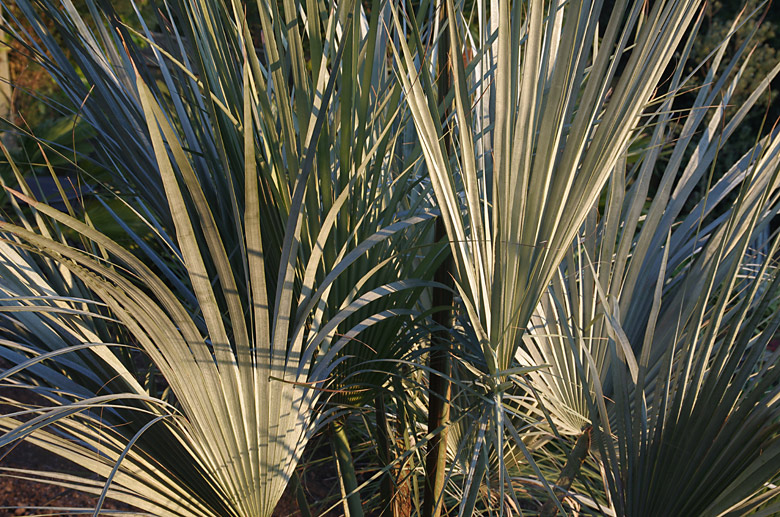 |
| Brahea armata is an impressive silver-leaved palm from Mexico. It is relatively slow-growing and is therefore either for the patient yet cash-strapped gardener or for the impatient 'instant effect' gardener whose pocket is deep. |
A palm with silvery leaves always makes me gasp. Chamaerops humilis 'cerifera' has aleady been mentioned but the, in my view, ultimate silvery-leaved palm suitable for the U.K. garden is without doubt the fan-leaved Brahea armata, the Blue Hesper Palm. At Southern Comfort, Torquay, it has lived through many winters without any sign of damage. Significantly my specimems have been small - which greatly increases risks of winter loss. Not all forms of B. armata are of in intense silvery colour and care should be taken when chosing a purchase - I would not trust the view that 'when it gets larger it becomes more silvery'. Be safe and buy one that is already silvery. However, even the green form is a worthwhile plant. I do not know whether B. armata has ever flowered in this country but if and when it does it will reward the owner with the most extraordinary arching inflorescences which extend way beyond the leaf tips. It is a slow-growing palm (my small specimens are only slightly less small after about eight years) and therefore it is probably wise to buy a larger specimen unless you are you and wish to keep the same garden for the next 20 years or so. Happily, at least at the time of writing, prices are not excessive. Costs begin to mount up only when the plant is too large or heavy for self-collection and when specialised equipment is required for planting. To quote R.L. Riffle & P. Craft (see above): "It is beautiful enough to be often planted as a single specimen, but it is as a loud accent in a mass of vegetation that it excels, its bluish starburst of leaves lending an almost unmached fillip to other forms and colors. It is stunningly spectacular in bloom."
Brahea nitida is similar in may ways and has the advantage of being faster-growing. A shade less hardy, with a thinner trunk, smooth petioles and possibly less silver in its leaves it is nevertheless a very worthwhile proposition. If you can find a supplier. Another species which is of note is B. edulis from the island of Guadalupe (not to be confused with Guadeloupe in the Carribean) of the Pacific coast of Mexico. This palm does not have any blue or silver in its leaves but the size of its attractively coloured green leaves impresses - up to two metres in diameter. This make it an ideal foliage plant when still small. Its zone 9 rating indicates -4°C as its lower limit but, as R.L. Riffle & P. Craft point out, it requires well-drained soil and winter dryness. The Guadalupe Palm became virtually extinct in its native habitat as a result of the introduction of goats in the 19th century. The goats are now gone and there are signs that the palm is gradually recovering. It is commonly planted elsewhere.
Torbay council have renently planted a number of smallish Brahea armata specimens in the palm section of Abbey Gardens close to the sea front in Torquay. This area, which contains many exotic species, is worth watching because it is a good 'litmus test' for hardiness in the region.
Sabal minor
Sabal minor is probably the hardiest of all palms. It is native to the south-eastern states of the USA and grows in boggy woodland and in cultivation it requires a similar environment. Though generally trunkless it is very attractive palm and may grow to six metres. Even in ideal conditions it is exceedingly slow-growing in the U.K. - my specimens rarely produce more than one leaf per year; this is no doubt the result of relatively low summer temperatures.
Cycads
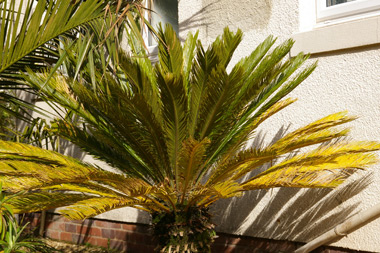 |
| Cycas revoluta growing in a garden in St Mark's Road, Meadfoot, Torquay. Originally planted in 2000, the plant has now been growing in this location for twelve years during which it has put on 15 cm of trunk. The plant must have been at least 25 years old when planted. The yellowing on the leaves of the plant may be due to poor soil but the owner maintains that low levels of fertilizer make the plant more frost resistant. This may certainly be true but the (much smaller) cycads in my own garden have overwintered successfully for many years while retaining a deeper green to the leaves. Low levels of nutrient may also slow down the appearance of new leaves and growth in general. This specimen produces a flush of some thirty leaves every 3 years. |
Cycads are not related to palms botanically but, because they superficially resemble palms, they are often grouped together in descriptions for the sake of convenience. Palms belong to the family Arecaceae which are flowering plants whereas the cycads - in the family Cycadaceae, are more closely related to the conifers.
Cycas revoluta (the Sago Palm), from Japan, is very well-known and is the only species which is readily available at garden centres and at specialized nurseries. It is not generally realized that this plant will take several degrees of frost; but is still a risky bet, even in milder areas, and far less hardy than any of the above palms. Nevertheless, they have been grown over many winters in sheltered areas here in the South-West and I have had a couple in the garden for over fifteeen years. They have not always received the care and attention that they require and therefore their rate of growth has been even slower than their normal already very slow rate of growth. A warm sunny position in good well-draining soil is ideal. (A neighbour in the Meadfoot area of Torquay has had this cycad for over twelve years (in 2012) and during this period it has put on some 15 cm (6") of trunk and the base of the crown stands at almost 50 cm (18") with leaves of just below one metre; it has overwintered in temperatures of minus 5°C with no visible damage.)
One of the hardiest of the cycads,Cycas panzhihuaensis (the Dukou/Doukou Cycad) from China, is difficult to obtain although seeds are sometimes offered. All cycads grow very slowly at the best of times and trying to get one up from seed is a tedious process. The alternative is to buy a mature one and never admit to your friends or even to yourself how much you paid. A C. panzhihuaensis which I germinated produced three leaves by its fourth season**. According to current knowledge this species may be the best for growing in the U.K.. Curiously, I have read in some places that C. panzhihuanensis is a fast-growing cycad - either the authors are mistaken or I am doing something very wrong with this plant. However, it is likely that growth may speed up as the cycad grows in size. This also happens to palms.
Notes
*"Cold-Hardy Palms for temperate European Landscapes", Chamaerops no 48, May 2004. The website for the European Palm Society is here (http://www.palmsociety.org/).** According to Tobias Spanner's website (http://www.rarepalmseeds.com/pix/CycPan.shtml) 'It is very fast and easy to grow, and, with heavy fertilizing, will produce three flushes of dark green to bluish leaves per year, and grow up to an incredible 60 cm (24 in.) of trunk in just five years from seed.' Obviously, it is easy to do something wrong!